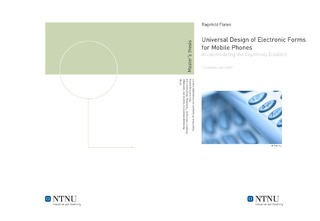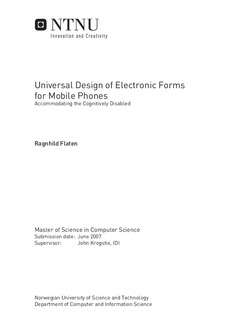| dc.description.abstract | Mobile phones are increasingly becoming common property, which we carry with us practically all of the time. Self-services are also becoming more and more common. Along with the self-service society comes the need to access services at any time, any place, which the mobile phone can provide for. Use of a self-service usually requires exchange of information by means of electronic forms. Finding good solutions for representing forms on mobile phones is a demanding challenge. On the one hand, the small displays and keyboards introduce several design challenges. On the other hand, users with special needs, such as users with cognitive impairments, call for solutions that address accessibility and universal design. This report documents an investigation on how to make electronic forms feasible on mobile phones. The investigation focused on universal design of mobile form user interfaces. Based on the expected potential of multimodality, two target groups were chosen: people with cognitive disabilities that lead to moderate text-reading problems , and people with cognitive disabilities that lead to moderate number-reading problems . We investigated the validity of a hypothesis containing two assertions: (1) that specific techniques and form controls can make electronic forms feasible on mobile phones as well as relieve the burden of the users, and (2) that offering visualisation of information as an additional modality in electronic forms on mobile phones can be beneficial for the cognitive processing of content in such forms. The research method used in the investigation comprised several parts: A literature study and a semi-structured theme interview formed a background for setting success criteria for the feasibility of forms on mobile phones and making design choices. Paper prototyping was conducted by making a paper mock-up of a selected case, kindergarten applications, which illustrated how the design choices could appear. The paper mock-up evolved through several iterations, and served as a design specification for a J2ME prototype, which was made in order for users to better be able to evaluate the design decisions. The design evolved further during the prototyping in J2ME, as necessary improvements were discovered. The final part of the research method was a walkthrough evaluation. Ten users went through the form and were afterwards asked to state their opinion on specific design aspects. The results from the walkthrough evaluations provided material to use when assessing the validity of the hypothesis. The investigation led to a list of success criteria with suggestions on how to achieve several of them. We attempted to achieve four of these criteria, by making several design decisions. The final user interface of the kindergarten form had aspects we were concerned about, and addressed in the walkthrough evaluations The most important results of the evaluations were: They were all positive towards a technique used for decreasing the information intensity. None of the users claimed to have problems with or dislike the form control drop-down box and a technique used to maintain the form context when drop-down boxes were expanded. Choose commands may be unnecessary. The solution for indicating form size and progress was understood by all. A graphical modality presenting kindergartens in a map, accommodating people with text-reading problems, was preferred by seven of the ten users, while none of the users preferred the graphical modality presenting points of time as clock icons, accommodating people with number-reading problems. The results led us to conclude that the first assertion seem to be correct, depending on the outcome of further, suggested tests. We assume that professionally made clock icons, combined with a technique suggested by one of the evaluators would have made more people prefer this presentation. We also se no reason why multimodality, acknowledged to be beneficial for the processing of cognitive content, should be less beneficial on mobile phones, and believe that also the second assertion is true. A number of efforts for further investigations are suggested. | nb_NO |

